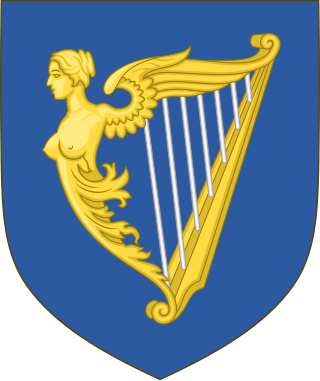Related Research Articles

Midlothian is a historic county, registration county, lieutenancy area and one of 32 council areas of Scotland used for local government. Midlothian lies in the east-central Lowlands, bordering the City of Edinburgh council area, East Lothian and the Scottish Borders.
The lieutenancy areas of Scotland are the areas used for the ceremonial lord-lieutenants, the monarch's representatives, in Scotland. The lord-lieutenants' titles chosen by the monarch and his legal advisers are mainly based on placenames of the traditional counties of Scotland. In 1794, permanent lieutenancies were established by Royal Warrant. By the Militia Act 1797, the lieutenants appointed "for the Counties, Stewartries, Cities, and Places" were given powers to raise and command County Militia Units.

The Chief Secretary for Ireland was a key political office in the British administration in Ireland. Nominally subordinate to the Lord Lieutenant, and officially the "Chief Secretary to the Lord Lieutenant", from the early 19th century until the end of British rule he was effectively the government minister with responsibility for governing Ireland, roughly equivalent to the role of a Secretary of State, such as the similar role of Secretary of State for Scotland. Usually it was the Chief Secretary, rather than the Lord Lieutenant, who sat in the British Cabinet. The Chief Secretary was ex officio President of the Local Government Board for Ireland from its creation in 1872.

Peeblesshire, the County of Peebles or Tweeddale is a historic county of Scotland. Its county town is Peebles, and it borders Midlothian to the north, Selkirkshire to the east, Dumfriesshire to the south, and Lanarkshire to the west.

Selkirkshire or the County of Selkirk is a historic county and registration county of Scotland. It borders Peeblesshire to the west, Midlothian to the north, Roxburghshire to the east, and Dumfriesshire to the south. It derives its name from its county town, the royal burgh of Selkirk. The county was historically also known as Ettrick Forest.

Lord Elibank, of Ettrick Forest in the County of Selkirk, is a title in the Peerage of Scotland. It was created in 1643 for Sir Patrick Murray, 1st Baronet, with remainder to his heirs male whatsoever. He had already been created a Baronet, of Elibank, in the Baronetage of Nova Scotia in 1628. His great-great-grandson, the fifth Lord, was an author and economist. He was succeeded by his younger brother, the sixth Lord, who was an admiral in the Royal Navy. On his death the titles passed to his nephew, the seventh Lord. He represented Peeblesshire in the House of Commons and also served as Lord Lieutenant of Peeblesshire.

Tweeddale is a committee area and lieutenancy area in the Scottish Borders council area in south-eastern Scotland. It had also been a province in the Middle Ages. From 1975 to 1996 it was a local government district. Its boundaries correspond to the historic county of Peeblesshire.

Sir James Montgomery, 1st Baronet Stanhope, FRSE was a Scottish advocate, judge, country landowner, agriculturalist and politician who sat in the House of Commons from 1766 to 1775. In 1783 he was a joint founder of the Royal Society of Edinburgh.
This is a list of people who served as Lord Lieutenant of Peeblesshire. The Lieutenancy has been replaced by the Lieutenancy of Tweeddale.

Edward Priaulx Tennant, 1st Baron Glenconner, styled Sir Edward Tennant, 2nd Baronet from 1906 to 1911, was a Scottish businessman and Liberal politician. In 1911 he was raised to the peerage as Baron Glenconner.
This is a list of people, who have served as Lord Lieutenant of Selkirkshire. The office was replaced by the Lord Lieutenant of Roxburgh, Ettrick and Lauderdale in 1975.
This is a list of those who have held the position of Lord Lieutenant of Cumbria. Cumbria was formed on 1 April 1974 by combining Cumberland and Westmorland, the area of Lancashire North of the Sands part of the Lonsdale Hundred and the former Sedbergh Rural District of the West Riding of Yorkshire.
This is a list of people who have served as Lord-Lieutenant of Shetland. The office was created when that of Lord Lieutenant of Orkney and Shetland was divided in 1948
Commander Montolieu Fox Oliphant Murray, 1st Viscount Elibank, was a British nobleman.
The High Sheriff of West Sussex is annually appointed as the sovereign's representative in West Sussex county for all matters relating to the judiciary and the maintenance of law and order.

Clan Lockhart is an ancient family from the Scottish Lowlands.
The High Sheriff of West Yorkshire is a current High Sheriff title which has existed since 1974, the holder is changed annually every March. For around 1,000 years the entire area of Yorkshire was covered by a single Sheriff of Yorkshire. After the Local Government Act 1972 the office of Sheriff was changed to High Sheriff and was split to cover several newly created counties, including West Yorkshire.

Sir Robert Heatlie Scott, was a British civil servant who became Permanent Secretary of the Ministry of Defence.
References
- Sainty, J. C. "Lieutenants and Lord-Lieutenants of Counties (Scotland) 1794-" . Retrieved 16 May 2014.